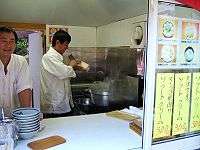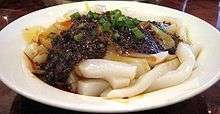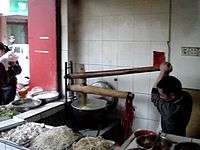Chinese noodles
|
| |
| Type | Noodles |
|---|---|
| Place of origin | China |
|
| |
Noodles are an essential ingredient and staple in Chinese cuisine. Chinese noodles vary widely according to the region of production, ingredients, shape or width, and manner of preparation. They are an important part of most regional cuisines within China, as well as in Singapore, and other Southeast Asian nations with sizable overseas Chinese populations.
Chinese-style noodles have also entered the cuisines of neighboring East Asian countries such as Korea (jajangmyeon) and Japan (ramen), as well as Southeast Asian countries such as Vietnam (hủ tiếu and mì xào are both examples of Vietnamese dishes that are of Chinese origin), the Philippines, Thailand, and Cambodia.
Nomenclature
Nomenclature of Chinese noodles can be difficult due to the vast spectrum available in China and the many dialects of Chinese used to name them. In Chinese, miàn (simplified Chinese: 面; traditional Chinese: 麵; often transliterated as "mien" or "mein" ) refers to noodles made from wheat, while fěn (粉) or "fun" refers to noodles made from rice flour, mung bean starch, or indeed any kind of starch. Each noodle type can be rendered in pinyin for Mandarin, but in Hong Kong and neighboring Guangdong it will be known by its Cantonese pronunciation ("min"). Taiwan, Malaysia, Singapore and many other Overseas Chinese communities in Southeast Asia may use Hokkien (Min Nan) instead ("mee").
History
The earliest written record of noodles is from a book dated to the Han dynasty (206 BC – 220 AD).[1] Noodles, often made from wheat dough, became a prominent staple of food during the Han dynasty.[2] During the Song dynasty (960–1279) noodle shops were very popular in the cities, and remained open all night. During the earlier dynastic periods Chinese wheat noodles were known as "soup cake" (湯餅), as explained by the Song dynasty scholar Huang Chaoying (黃朝英) mentions in his work "A delightful mixed discussion on various scholarly topics" (Chinese: 靖康緗素雜記; pinyin: jìngkāngxiāngsùzájì, Scroll 2) that in ancient times bready foods like pasta are referred collectively as "bing" and differentiated through their cooking methods.[3]
In 2002, archaeologists found an earthenware bowl containing world's oldest known noodles, about 4000 years old, at the Lajia archaeological site of the Qijia culture along the Yellow River in China.[1][4][5] The noodles were well-preserved.[1][4] After analysing the noodle remains in 2004,[4] it was determined that the noodles were made from foxtail millet and broomcorn millet.[1][4][5][6]
Production
Chinese noodles are generally made from either wheat flour, rice flour, or mung bean starch, with wheat noodles being more commonly produced and consumed in northern China and rice noodles being more typical of southern China. Egg, lye, and cereal may also be added to noodles made from wheat flour in order to give the noodles a different color or flavor. Egg whites, arrowroot or tapioca starch are sometimes added to the flour mixture in low quantities to change the texture and tenderness of the noodles' strands. Although illegal, the practice of adding the chemical cross-linker borax to whiten noodles and improve their texture is also quite common in East Asia.[7]
The dough for noodles made from wheat flour is typically made from wheat flour, salt, and water, with the addition of eggs or lye depending on the desired texture and taste of the noodles. Rice- or other starch-based noodles are typically made with only the starch or rice flour and water. After the formation of a pliable dough mass, one of five types of mechanical processing may be applied to produce the noodles:
| English | Chinese | Pinyin | Process |
|---|---|---|---|
| Cut | 切 | qiē | The dough is rolled out into a flat sheet, folded, and then cut into noodles of a desired width. |
| Extruded | 挤压 | jǐyā | The dough is placed into a mechanical press with holes through which the dough is forced to form strands of noodles. |
| Peeled | 削 | xiāo | A firm dough is mixed and formed into a long loaf. Strips of dough are then quickly sliced or peeled off the loaf directly into boiling water.[8] |
| Pulled | 拉 | lā | The dough is rolled into a long cylinder, which is then repeatedly stretched and folded to produce thinner and thinner strands.[9] |
| Kneaded | 揉 | róu | A ball of dough is lightly rolled on a flat surface or kneaded with one's hands until it is formed into the desired shape.[10] |
| Flicked | 柭 | bó | A soft dough is prepared, placed in a bowl, strips of dough are pulled and flicked directly into boiling water using a flexible bamboo stick or chopstick.[11] |
While cut and extruded noodles can be dried to create a shelf-stable product to be eaten months after production, most peeled, pulled and kneaded noodles are consumed shortly after they are produced.
-

Peeling thin strips of dough from a loaf directly into a container of boiling water to make daoxiaomian (刀削面)
-
Pulling wheat dough into thin strands to form lamian
-
Noodle maker in Peng Zhou extruding noodles directly into a pot of boiling water.
Cooking

Noodles may be cooked from either their fresh (moist) or dry forms. They are generally boiled, although they may also be deep-fried in oil until crispy. Boiled noodles may then be stir fried, served with sauce or other accompaniments, or served in soup, often with meat and other ingredients. Certain rice-noodles are made directly from steaming the raw rice slurry and are only consumed fresh.
Unlike many Western noodles and pastas, Chinese noodles made from wheat flour are usually made from salted dough and therefore do not require the addition of salt to the liquid in which they are boiled. Chinese noodles also cook very quickly, generally requiring less than 5 minutes to become al dente and some taking less than a minute to finish cooking, with thinner noodles requiring less time to cook. Chinese noodles made from rice or mung bean starch do not generally contain salt.
Types
Wheat
These noodles are made only with wheat flour and water. If the intended product are dried noodles, salt is almost always added to the recipe.
| Common English name | Characters | Pinyin | Cantonese | Hokkien | Thai | Thai transliteration | Western equivalent | Description |
|---|---|---|---|---|---|---|---|---|
| Cat's ear | 貓耳朵 | māo ěr duǒ | maau yi do | - | Orecchiette | Looks like a cat's ear | ||
| Cold noodles | 凉面/涼麵 | liáng miàn | lahng mein | - | Served cold | |||
| Dao xiao mian | 刀削面 / 刀削麵 | dāo xiāo miàn | doe seuk mein | Relatively short flat noodle peeled by knife from a firm slab of dough | ||||
| Lamian | 拉麵 | lā miàn | laai mein | - | บะหมี่ | ba mee | Hand-pulled noodles from which ramen was derived. | |
| Yaka mein (Yat Ca Mein, Yet Ca Mein) | - | North American Chinese style wheat noodles similar to spaghetti; sold in Canada and the United States | ||||||
| Lo mein | 捞面/撈麵 | lāo miàn | lo mein | lo mi | - | egg noodles that are stir fried with sliced vegetables and/or meats and other seasonings | ||
| Misua | 面线/麵線 | miàn xiàn | mein sin | misua | หมีซั่ว | mee sua | Long, short, very fine Vermicelli | Thin, salted wheat noodles (1 mm diameter). Can be caramelized to a brown colour through extensive steaming |
| 宮麵 | gōng miàn | |||||||
| Saang mein | 生面/生麵 | shēng miàn | saang mein | - | Soapy texture | |||
| Thick noodles | 粗面/粗麵 | cū miàn | cho mein | Thick wheat flour noodles, from which udon was derived. | ||||
Lye-water or egg
These wheat flour noodles are more chewy in texture and yellow in colour either due to the addition of lye (sodium carbonate, potassium carbonate, calcium hydroxide, or potassium hydroxide) and/or egg. This class of lye water noodles (Chinese: 碱面/碱麵; pinyin: jiǎn miàn) has a subtle but distinctive smell and taste, described by some as being "eggy".[12]
| Common English name | Characters | Pinyin | Cantonese | Hokkien | Thai | Western equivalent | Description |
|---|---|---|---|---|---|---|---|
| Oil noodles | 油面/油麵 | yóu miàn | jau4 min | - | Made of wheat flour and egg or lye-water; often comes pre-cooked | ||
| Thin noodles | 幼面/幼麵 | yòu miàn | jau mein | Thin lye-water noodles; one of the most common Cantonese noodles | |||
| Mee pok | 麵薄 | miàn báo | - | mee pok | mee pok | Linguine | Flat egg or lye-water noodles |
| Yi mein | 伊麵 伊府麵 | yī miàn yī fǔ miàn | yi mein yee min yee foo min e-fu | ee mee ee foo mee | - | Fried, chewy noodles made from wheat flour and egg or lye-water | |
| Shrimp roe noodles | 蝦子麵 | xiā zǐ miàn | ha tsz min | - | Made of wheat flour, lye-water, and roe, which show up as black spots | ||
| Jook-sing noodles | 竹昇麵 | zhú shēng miàn | zuk1 sing1 min6 | a rare type of Cantonese noodle in which the dough is tenderized with a large bamboo log. | |||
Rice
Rice based noodles can be:
- Extruded from a paste and steamed into strands of noodles
- Steamed from a slurry into sheets and then sliced into strands
These noodles are typically made only with rice and water without the addition of salt. Although unorthodox, some producers may choose add other plant starches to modify the texture of the noodles.
| Common English name | Characters | Pinyin | Cantonese | Hokkien | Thai | Thai transliteration | Western equivalent | Description |
|---|---|---|---|---|---|---|---|---|
| Kway teow | 粿条 | gǔo tiáo | kwai tiu | kway teow | ก๋วยเตี๋ยว | Guay Teow | Rice fettuccine | Flat rice noodles |
| Ho fun, Chow fun | 沙河粉 | Shā hé fěn | - | Rice pappardelle | Very wide, flat, rice noodles | |||
| 河粉 | hé fěn | ho fun | hor fun | เส้นใหญ่ | Sen Yai | |||
| Lai fun | 瀨粉 酹粉 | lài fěn | laai fun | - | Rice spaghetti | Thick round semi-transparent noodle made from sticky rice | ||
| Mai sin | 米線 米线 | mǐ xiàn | mai sin | Bee sua | เส้นเล็ก | Sen lek | Rice spaghettini | Rice noodles also called Guilin mífěn (桂林米粉) |
| Rice vermicelli | 米粉 | mí fěn | mai fun | bee hoon | เส้นหมี่ | Sen mee | - | Thin rice noodles |
Starch

These noodles are made using various plant starches. Mung bean starch noodles will often be cut with tapioca starch to make them more chewy and reduce production costs.
| Common English name | Characters | Pinyin | Cantonese | Hokkien | Thai | Thai transliteration | Western equivalent | Description |
|---|---|---|---|---|---|---|---|---|
| Winter noodles | 冬粉 | dōng fěn | dung fun | dang hun | - | Thin mung bean vermicelli | Very thin mung bean starch noodles | |
| Bean threads | 粉絲 | fěn sī | fun sze | - | วุ้นเส้น | Wun sen | Mung bean vermicelli | Thin cellophane-like noodles |
| Mung bean sheets | 粉皮 | fěn pí | fan pei | - | Wide, clear noodles made from mung bean starch | |||
| Liang pi | 凉皮 | líang pí | - | Translucent noodles made from wheat starch left from producing gluten | ||||
| Silver needle noodles | 銀針粉 | yín zhēn fěn | ngàhn jām fán | Spindle-shaped wheat starch noodles, ca. 5 cm in length and 3–5 mm in diameter | ||||
| 老鼠粉 | lǎo shǔ fěn | lóuh syú fán | ngiau chu hoon | |||||
| Suān là fěn | 酸辣粉 | Suān là fěn | chuan lao fán | - | Sweet Potato vermicelli | Chongqing Hot & Spicy sweet potato starch noodles | ||
Chinese noodle dishes
The following are a small portion of Chinese dishes that incorporate noodles:
- Ban mian
- Beef chow fun
- Cart noodle
- Char kway teow
- Cup Noodles
- Zhajiangmian
- Laksa
- Lo mein
- Re gan mian
See also
References
- 1 2 3 4 Roach, John. "4,000-Year-Old Noodles Found in China". National Geographic. Retrieved 12 October 2011.
- ↑ Sinclair, Thomas R.; Sinclair, Carol Janas (2010). Bread, beer and the seeds of change : agriculture's imprint on world history. Wallingford: CABI. p. 91. ISBN 978-1-84593-704-1.
- ↑ 黃, 朝英, 靖康緗素雜記 (in Chinese), 2
- 1 2 3 4 Ye, Maolin; Lu, Houyua. "The earliest Chinese noodles from Lajia". The Institute of Archaeology. Chinese Academy of Social Sciences. Retrieved 12 October 2011.
- 1 2 "Oldest noodles unearthed in China", BBC News, 12 October 2005
- ↑ Lu, Houyuan; Yang, Xiaoyan; Ye, Maolin; Liu, Kam-Biu; Xia, Zhengkai; Ren, Xiaoyan; Cai, Linhai; Wu, Naiqin; Liu, Tung-Sheng (13 October 2005). "Culinary archaeology: Millet noodles in Late Neolithic China". Nature. 437 (7061): 967–968. doi:10.1038/437967a.
- ↑ 使用硼砂替代品吃得更安心, 彰化縣衛生局 (Changhua county health bureau), 2008-09-04
- ↑ 中国美食探秘 (Secrets of Chinese Cuisine) (5 (面点: 21:55)), 中国中央电视台 (CCTV), 2014-11-07
- ↑ 中国美食探秘 (Secrets of Chinese Cuisine) (5 (面点: 20:35)), 中国中央电视台 (CCTV), 2014-11-07
- ↑ 中国美食探秘 (Secrets of Chinese Cuisine) (5 (面点: 20:06)), 中国中央电视台 (CCTV), 2014-11-07
- ↑ 中国美食探秘 (Secrets of Chinese Cuisine) (5 (面点: 21:13)), 中国中央电视台 (CCTV), 2014-11-07
- ↑ McGEE, HAROLD (2010-09-14), For Old-Fashioned Flavor, Bake the Baking Soda, The New York Times Company
External links
| Wikimedia Commons has media related to Noodles from China. |

